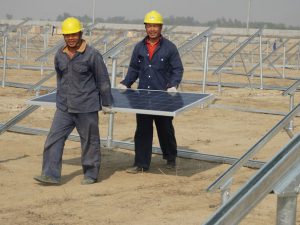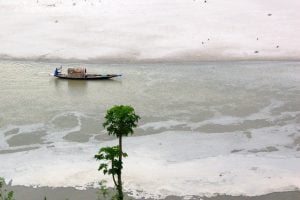T. Namgyal, a 65-year-old farmer who lives in Hunder village of Nubra Valley, has seen the growing water scarcity in Ladakh. In the past few decades, snowfall has considerably declined and now there is little water in the rivers and streams, he says.
“Earlier, there was very heavy snowfall in this area. Until 20-30 years ago, the Khardung-La pass would remain closed for six months. Now the snowfall is low, and it has affected the health of our rivers and water streams. Our crops are failing due to scarcity of water,” Namgyal said.
![T. Namgyal, a farmer living in Hunder village of Nubra valley in Ladakh, says snowfall has reduced drastically, which has affected the availability of water for vegetables and crops [image by: Hridayesh Joshi]](https://dialogue.earth/content/uploads/2018/09/Pix-1-Namgyal.png)
Standing in his fields, Nurboo points towards the mountains. “Can you see up there? Earlier those (mountains) were all covered by snow. Now there is no snow and the glaciers have melted. Water has reduced in these streams and often they get dry. We fear the problem will increase in the coming years.”
The numbers are alarming. There was 50% to 80% deficit in annual precipitation in Ladakh between 2013 and 2017, and 2016 was a year of record low rain.
Ladakh is a cold desert and its arid climate makes conditions harsh for agriculture. Almost 90% of farmers in Ladakh are dependent on snowmelt water for irrigation. Scientists say the water problem in this area is mainly due to climate change. There has already been a 3 degree Celsius rise in average temperature of Ladakh in the past four decades. This has caused less snowfall and faster snowmelt in the higher regions.
In western Himalayas, the glacier cover has reduced by almost 20% and some of the glaciers are facing an existential threat. Experts say global warming has affected the rainfall pattern adversely in these higher regions.
The result: crop productivity for farmers like Nurboo and Namgyal have been badly hit. Production of some crops declined by 30% to 50% in the past few years. Crops such as potato, barley, turnip, radish and peas have suffered due to non-availability of water.
![Besides lower snowfall, the recent boom in tourism has also affected water availability in Ladakh [image by: Hridayesh Joshi]](https://dialogue.earth/content/uploads/2018/09/PIX-3-TOP-ANGLE.jpg)
Near Diskit village in Nubra, women say that growing even grass as fodder for livestock is difficult now. “Agriculture has become difficult, but we are dependent on animal husbandry as well,” says 55-year-old Amina. “Now the grass doesn’t grow as high and thick in the fields (as earlier times). This has compounded our problems.”
![The Shyok River in Nubra Valley, a tributary of the Indus River, is one of the biggest rivers in Ladakh that originates at the Rimo glacier [image by: Hridayesh Joshi]](https://dialogue.earth/content/uploads/2018/09/Pix-4-River.jpg)
Fight back
Downstream at Leh, the capital of Ladakh, civil engineer and farmer Chewang Norphel is combating the water problem by creating artificial glaciers. His technique is simple — divert the water stream and slow down its speed during the winters so that it would freeze due to low temperature. To do this, Norphel pioneered the idea of stone embankments in the course of water streams, making shallow pools along the slope.
This ingenious way helps to conserve water as ice in the form of an artificial glacier. During spring, the ice starts melting and water is available for irrigation. Many farmers in different villages of Ladakh replicate this experiment.
![The experiment of artificial glaciers has provided rich dividends for agriculture [image courtesy: Chewang Norphel]](https://dialogue.earth/content/uploads/2018/09/Pix-5-artificial-glacier.jpg)
“My technique is simple, and it is all about slowing down the speed of current during winters. It helps to solve the problem of water for irrigation but there is an additional advantage of artificial glacier,” Norphel said. “It becomes a good source of groundwater recharge, which is much needed in Ladakh as tourism is growing and people are extracting groundwater for daily use.”
There is another way to conserve water, which is embedded in tradition in Ladakh. Many households use dry latrines in their homes, which reduce the water consumption for sanitation. Human waste is covered by soil, which helps in decomposing and turns it in manure to be used in fields.
![The use of dry toilets in Ladakh saves water and helps to produce organic manure at no additional cost [image by: Hridayesh Joshi]](https://dialogue.earth/content/uploads/2018/09/pix6-Dry-toilet.jpg)
At his home, Norphel explains this. Showing the dry toilet built in a small room, he says, “After use, we drop a shovel of soil in the pit. We do it every time we use the toilet and after one year we empty the tank and clean it. We then dump all of this for another year and it becomes very good manure for our fields. It is all organic and we save water in the process.”
However, many believe efforts by individuals alone will not avert the crisis. This is where the role of state and central government is important to put appropriate policy measures and provide resources to scale up the efforts by farmers. Investment in technology can be a prudent step as methods like drip irrigation and precision irrigation can save a lot of water.
Flip side
However, there is another aspect of global warming, which is termed as a positive effect of climate change. Now it is possible to grow several crops and vegetables in Ladakh, which was impossible earlier. Farmers nowadays grow capsicum, cucumber, cauliflower, tomatoes, okra and even watermelon. “Rise in temperature has made this possible here. Earlier you couldn’t think of growing them here at all,” says Namgyal of Hunder village, with a hearty laugh.
Several farmers in Nubra valley and other parts of Ladakh also testify to this. “We had limited options to grow crops like potatoes, turnip, peas, radish and a few more vegetables,” said 44-year-old Gulam Qadir. “Now the situation has changed.”
Chewang Norphel, who has grown several vegetables and fruits in his garden in Leh, says, “The negative impact is huge on us but the positive (effect) is that now you can find more than 40 to 50 species of vegetables here and side by side you can grow many fruits. You know during earlier days the fruit trees could be grown only up to Leh. Now we can grow this fruit trees even 70 km up from Leh.”

So, is climate change good or bad news for the farmers in these high-altitude regions?
Experts say it is not just the rise in temperature that is showing this so-called positive change. Scientists are also working towards new seeds, and germplasm suitable for the new conditions. Researchers and scientists are trying to develop variety of crops like heat-resistant wheat. Different research centres are working to develop varieties that will grow under the changed climate, and they are also looking at the technologies that are more water-wise.
“Climate Change is not going to have a uniform impact everywhere,” said TERI’s Dhawan. India being a large country with different agro-climatic zones, somewhere there would be gains, while other areas stand to lose out. But overall, “India is going to be a loser,” she said.
This article was originally published in indiaclimatedialogue.net.
Also read: The iceman of Ladakh
Also read: Experts blast and dig channel to drain blocked Ladakh river
![<p>Ladakh is a cold desert, which makes farming difficult due to its arid climate. It leaves farmers with limited options [image by: Hridayesh Joshi]</p>](https://dialogue.earth/content/uploads/2018/09/Climate-change-Ladakh.jpg)

![In a village on the edge of the Sundarbans and facing the Bay of Bengal, Jasimuddin Sarkar in front of his farm that now grows nothing, thanks to sea level rise, and his house that gets flooded with dirty saline water every third or fourth day [image by: Joydeep Gupta]](https://dialogue.earth/content/uploads/2018/10/Farmer_Jasimuddin_Sarkar_Baliara_Mousuni_Joydeep-e1515995272635-300x200.jpg)


![Silt farmers growing vegetables on sand deposited by the Gandak river [image by: Nidhi Jamwal]](https://dialogue.earth/content/uploads/2018/10/IMG_3663-300x225.jpg)


